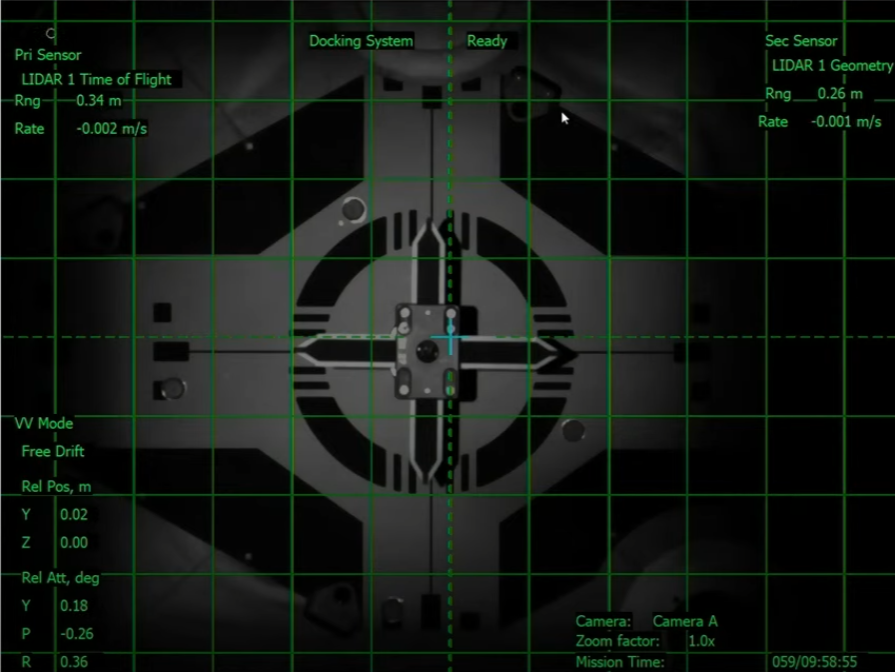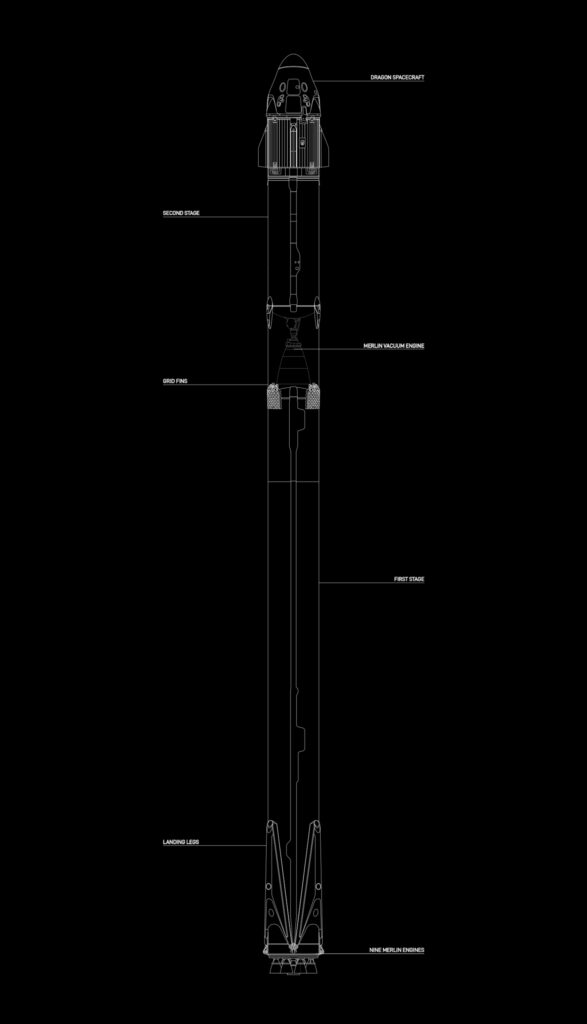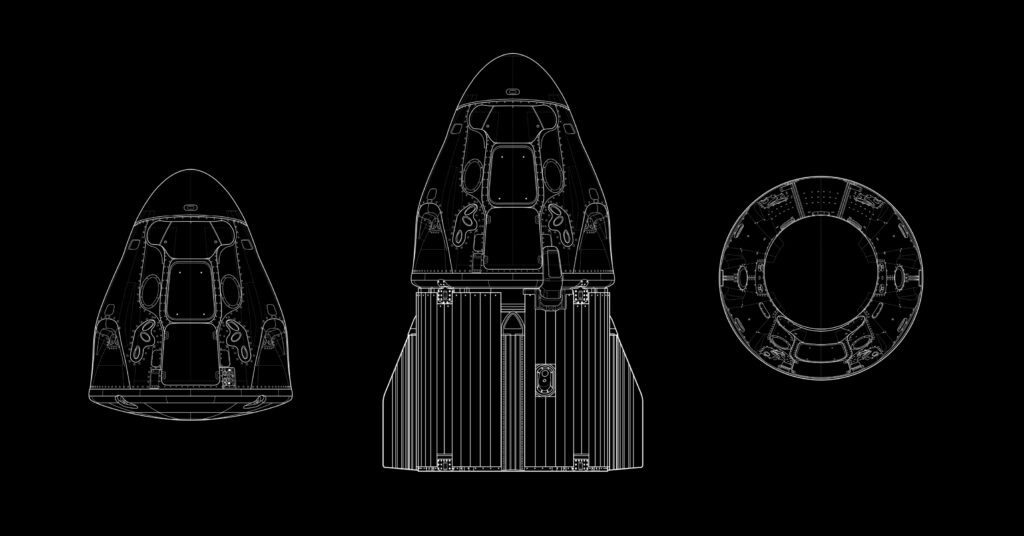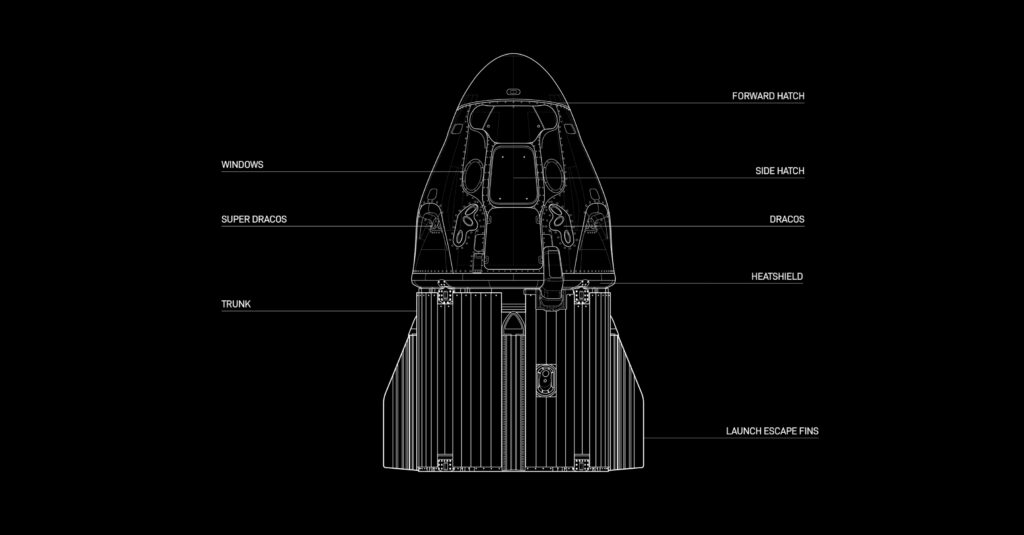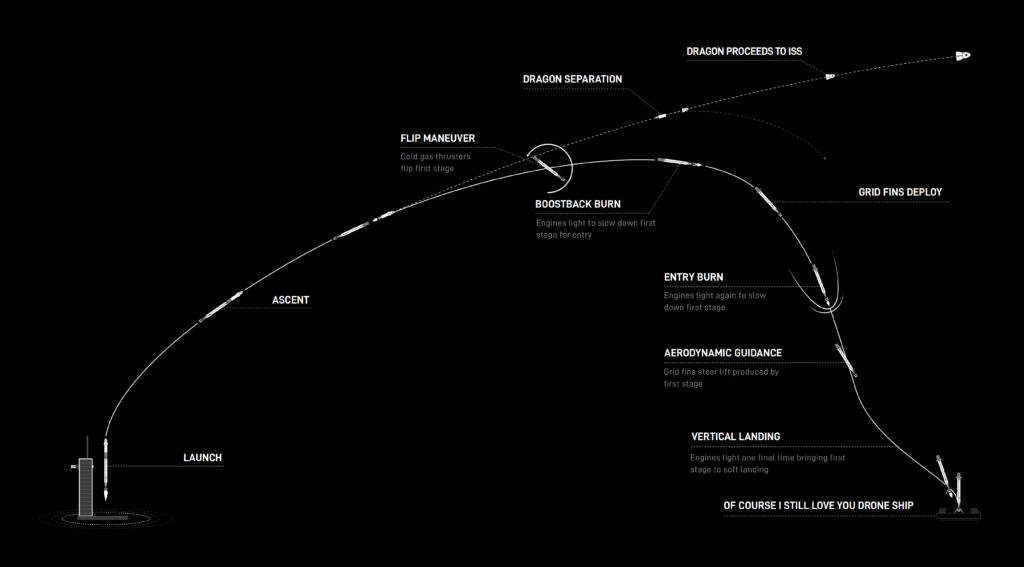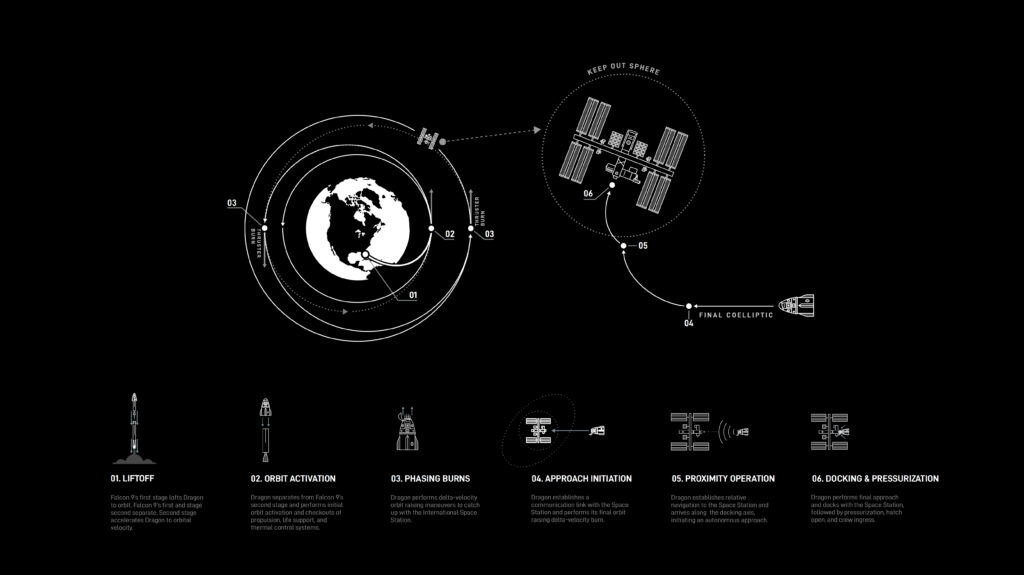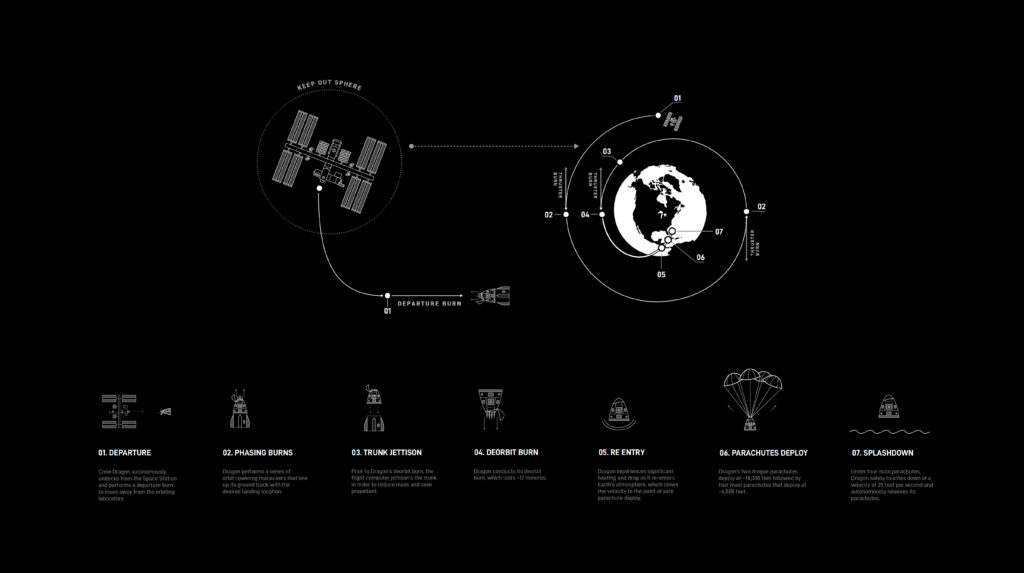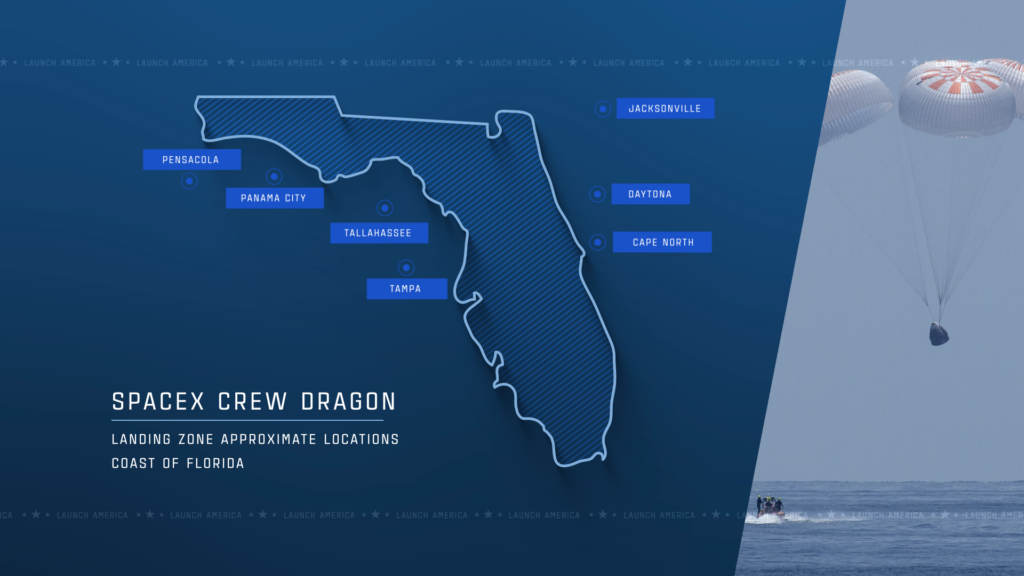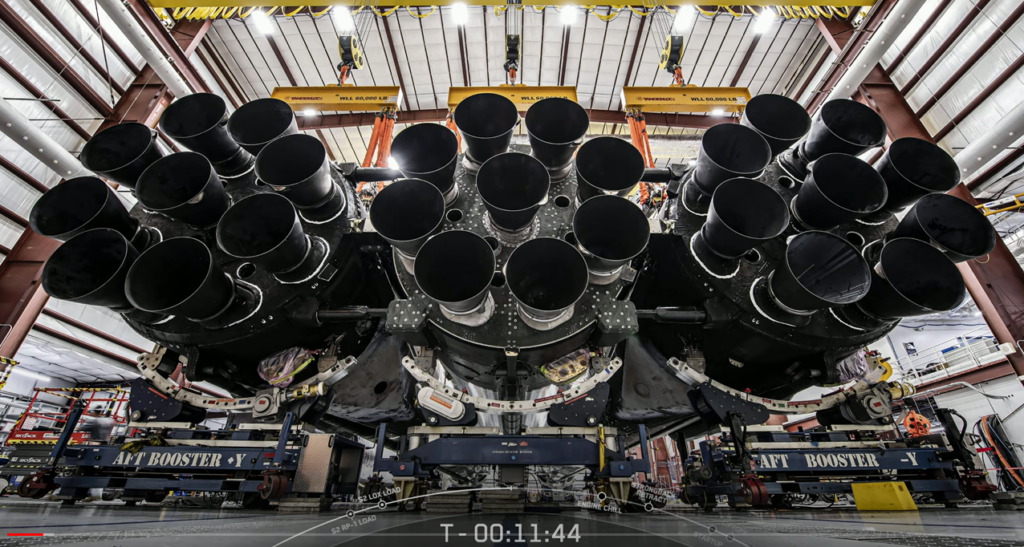SpaceX Falcon 9, Crew Dragon and Falcon Heavy sequence of events
Launch Falcon 9 with EUCLID space telescope (01-07-2023)
Mission
- SpaceX Falcon 9 rocket and ESA Euclid satellite from NASA’s Kennedy Space Center (KSC).
- ESA Euclid space telescope (dark matter and dark energy).
- Launch: 01-07-2023.
- From: KSC SLC-40.
- Telemetry and telecom: ESA DS1, DS2 and DS3.
- Destination: L2.
Sequence of events
| Event | Time | Speed | Altitude | Remarks | ||
| Falcon 9 Launch | T+0 (01-07-2023) | 0 km/h | 0 km | KSC SCS-40 | ||
| SECO-1 | 26.979 km/h | 162 km | ||||
| Drift phase | Stable drift from KSC to equator | |||||
| SES-2 | T+17:22 | Second burn, 90 seconds duration | ||||
| SECO-2 | T+18:40 | 38.177 km/h | 200 km | |||
| Deploy | T+41:03 | 27.356 km/h | 5.675 km | Payload deploy, 20 minutes after SECO-2 | ||
| Acquisition of signal by ESA | T+45:10 | ESA DSA1 = New Norcia, Australia | ||||
| Telemetry | ESA DSA2 = Cebreros, Spain, DS3 = Malargue, Argentina |
Launch Falcon 9 + Crew 6 (01-03-2023)
Mission
- SpaceX Falcon 9 rocket (9 engines) and Crew Dragon spacecraft from NASA’s Kennedy Space Center (KSC).
- Crew 6 to ISS.
- First launch attempt: 27-02-2023.
- Launch: 01-03-2023 (second attempt).
- Day 2: 02-03-2023.
- Day 3: 03-03-2023.
Flight phases (Liftoff to Pressurization)
- Liftoff
Falcon 9’s first stage lofts Dragon to orbit. Falcon 9’s first and second stage separate. Second stage accelerates Dragon to orbital velocity. - Orbit activation
Dragon separates from Falcon 9’s second stage and performs initial orbit activation and checkouts of propulsion, life support and thermal control systems. - Phasing burns
Dragon performs delta-velocity orbit raising maneuvers to catch up with the International Space Station (ISS). Thruster burns. - Approaching initiation
Dragon establishes a communication link with the ISS and performs its final orbit raising delta-velocity burn. - Proximity operation
Dragon establishes relative navigation to the ISS and arrives along the docking axis, initiating an autonomous operation. Final coeliptic. - Docking and pressurization
Dragon performs final approach abd docks with the ISS, followed by pressurization, hatch open and crew ingress.
Day 1 (first attempt)
SpaceX scrubbed the first launch attempt Feb. 27 a little more than two minutes before the scheduled 1:45 a.m. Eastern liftoff after reporting an issue with the flow of triethylaluminum triethylborane (TEA-TEB), a chemical combination used to ignite the rocket’s engines.
“At the end of the day, we couldn’t be absolutely sure that we had enough TEA-TEB, enough of this ignition fluid, bled up to the interface of the rocket to make sure that we would get that consistent, exactly timed ignition that we need across all nine engines, so we scrubbed the launch,” said Benji Reed, senior director of human spaceflight programs at SpaceX, at a post-launch briefing.
Day 1 (second attempt)
The launch took place on the second attempt:
- 07:04:57 p.m. EST: Chief engineer launch readiness briefing
- 07:34:57 p.m. EST: Launch shift arrives in Firing Room 4
- 07:34:57 p.m. EST: Dragon IMU align/configure for launch
- 08:04:57 p.m. EST: Dragon prop pressurization
- 08:09:57 p.m. EST: Dragon launch escape system health checks
- 08:16:57 p.m. EST: Crew weather brief
- 08:26:57 p.m. EST: Crew handoff to SpaceX
- 08:34:57 p.m. EST: Suit donning and checkouts
- 08:34:57 p.m. EST: Readiness poll for advance team to enter Blast Danger Area
- 08:39:57 p.m. EST: Advance team travels to pad 39A
- 08:44:57 p.m. EST: ISS state vector uploaded to Dragon
- 08:45:00 p.m. EST: NASA TV coverage begins
- 09:14:14 p.m. EST: Crew walkout from Neil Armstrong O&C Building
- 09:19:14 p.m. EST: Crew departs for pad 39A in Tesla Model Xs
- 09:39:14 p.m. EST: Crew arrives at pad 39A
- 09:59:14 p.m. EST: Astronauts ingress into Crew Dragon
- 10:14:14 p.m. EST: Crew communications checks
- 10:17:14 p.m. EST: Verify ready for seat rotation
- 10:18:14 p.m. EST: Suit leak checks
- 10:39:14 p.m. EST: Hatch closed for flight
- 10:44:14 p.m. EST: Dragon leak checks
- 11:49:14 p.m. EST: SpaceX launch director verifies go for propellant load
- 11:52:14 p.m. EST: Crew access arm retracts
- 11:56:14 p.m. EST: Launch escape system armed
- 11:59:14 p.m. EST: 1st and 2nd stage RP-1 fuel load begins; 1st stage LOX load begins
Day 2
- 12:14:44 a.m. EST: 2nd stage RP-1 tank full
- 12:17:44 a.m. EST: 2nd stage LOX load begins
- 12:24:14 a.m. EST: Final pre-launch communications check
- 12:27:14 a.m. EST: 1st stage engine chill begins
- 12:28:14 a.m. EST: 1st stage RP-1 tank full
- 12:29:14 a.m. EST: Dragon transitions to internal power
- 12:29:44 a.m. EST: Release clamps open. Strongback retraction begins (to 70% at Vandenberg)
- 12:30:34 a.m. EST: Autonomous Flight Termination System final setup
- 12:31:09 a.m. EST: M-Vac engine igniter purge
- 12:31:14 a.m. EST: 1st stage LOX tank full; Strongback at ~1.7 degrees
- 12:32:14 a.m. EST: 2nd stage LOX tank full
- 12:33:14 a.m. EST: Flight computer starts final pre-flight checks; F9 prop tanks pressurize
- 12:33:29 a.m. EST: SpaceX launch director verifies go for launch
- 12:34:11 a.m. EST: Engine controller commands engine ignition sequence
- 12:34:14 a.m. EST: Falcon 9 and Crew Dragon launch (T+0)
- 12:34:14 a.m. EST: Stage 1a abort mode
- 12:34:24 a.m. EST: Pitch kick
- 12:35:07 a.m. EST: Stage 1 throttle bucket
- 12:35:16 a.m. EST: Max-Q
- 12:35:23 a.m. EST: Mach 1
- 12:35:29 a.m. EST: Stage 1b abort mode
- 12:36:48 a.m. EST: Stage 2a abort mode
- 12:36:48 a.m. EST: MECO; 1st stage engines cut off
- 12:36:52 a.m. EST: Stage separation
- 12:36:59 a.m. EST: 2nd stage’s M-Vac engine ignites
- 12:38:34 a.m. EST: Bermuda ground station acquires F9 and Dragon signals
- 12:41:36 a.m. EST: 1st stage entry burn
- 12:43:01 a.m. EST: SECO-1; 2nd stage M-Vac engine shuts down; Orbit insertion
- 12:43:13 a.m. EST: 1st stage landing burn
- 12:43:40 a.m. EST: 1st stage landing on droneship
- 12:46:11 a.m. EST: Dragon separates from 2nd stage; Begin Draco thruster checkouts
- 12:46:59 a.m. EST: Dragon nosecone open sequence begins
- 01:20:11 a.m. EST: Phase burn using Draco thrusters
- 02:30:00 a.m. EST: Post-launch news conference on NASA TV
- 10:24:13 a.m. EST: Boost burn using Draco thrusters
- 11:06:25 a.m. EST: Close burn using Draco thrusters
- 07:04:31 p.m. EST: Transfer burn using Draco thrusters
- 07:51:02 p.m. EST: Coelliptic burn using Draco thrusters
- 10:11:00 p.m. EST: Crew Dragon range 30 kilometers from ISS
- 11:02:00 p.m. EST: Crew Dragon range 15 kilometers from ISS
- 11:16:00 p.m. EST: Go/no go decision for approach initiation burn
- 11:19:00 p.m. EST: Crew Dragon range 10 kilometers from ISS
- 11:41:00 p.m. EST: Approach initiation burn; Crew Dragon range 7.5 kilometers from ISS
- 11:47:00 p.m. EST: Crew Dragon range 6 kilometers from ISS
Day 3
- 12:06:00 a.m. EST: Approach initiation midcourse burn
- 12:13:00 a.m. EST: Crew Dragon range 1 kilometer from ISS
- 12:22:00 a.m. EST: Go/no go decision to enter ISS keep out sphere (a 200-m zone around ISS)
- 12:26:00 a.m. EST: Waypoint Zero arrival (400 meters below ISS)
- 12:40:00 a.m. EST: Go/no go decision to approach Waypoint 2
- 01:00:00 a.m. EST: Docking axis/Waypoint 1 arrival (220 meters above ISS)
- 01:10:00 a.m. EST: Go/no go decision for docking
- 01:11:00 a.m. EST: Waypoint 2 arrival and hold (20 meters from ISS)
- 01:12:00 a.m. EST: Resume approach from Waypoint 2 (20 meters from ISS)
- 01:17:00 a.m. EST: Contact and capture at IDA-3 on zenith port of the Harmony module
- 01:30:00 a.m. EST: Docking sequence complete; All hooks closed; Power umbilicals mated
- 01:52:00 a.m. EST: Leak checks begin between Crew Dragon and ISS
- 02:17:00 a.m. EST: Leak checks complete; Vestibule pressurization
- 03:02:00 a.m. EST: Hatch opening; Crew-6 astronauts enter ISS (26,5 hours after launch)
Issue
- 02-03-2023 When crew 6 docked at the ISS, there were problems with one of the twelve hooks.
Polaris Dawn Missions
Mission I (10-09-2024)
- 10-09-2024 Launch Falcon 9 + Crew Dragon (Resilience).
- 11-09-2024 Reached 1,400 km above Earth’s surface. This marks the highest spaceflight since the Apollo missions and beats the records set during NASA’s Gemini program in the 1960s.
- 12-09-2024 1st-ever private spacewalk.
-
- The pioneering extravehicular activity (EVA) will be conducted by Jared Isaacman and Sarah Gillis, two members of the four-person Polaris Dawn mission.
-
Crew Dragon doesn’t have an airlock, so its entire interior will be exposed to the vacuum of space during the EVA. That means all four crewmembers (Isaacman, Gillis, Scott “Kidd” Poteet and Anna Menon) are completely dependent on the new SpaceX EVA suits.
-
Only Isaacman and Gillis will exit the capsule sequentially.
-
Each will remain outside for 15 to 20 minutes.
-
Both of them plan to maintain contact with Crew Dragon using “Skywalker” handrails during the EVA.
- Flight objectives: Test out new designed EVA suits by SpaceX to validate suit mobility designs, including specially designed hand and foot holds that the crew will use to attempt to maneuver.
- Starlink not used (some communication blackouts expected over the Pacific, no ground stations).
-
- 12-09-2024 Sequence of events
-
- Slowly wash nitrogen from the blood by breathing pure oxygen in the cabin for 24 hours.
- EVA preparation (Pressure O2 up and N2 down)
- Cabin pressure 8,6 PSI, speed 25.528 km/h, altitude 678 km)
- Suit donning
- 1:06:19 Seat rotation
- 1:07:13 Awaiting prep suit leak check
- 1:08:24 Prep suit leak check
- 1:10:15 HUD (Heads Up Display) checkout (powered up):
-
- O2-flow timer (max 1 hour and 50 minutes). Flow running.
- Suit pressure
- Suit temperature
-
- 1:11:00 Also in use: EMU (Extravehicular Mobility Unit)
- 1:12:55 Nominal: Dragon 8,6 PSI and suit 8,6 PSI.
- 1:13:00 Helmet cams on.
- 1:15:00 Checking lighting, umbilical, tethered, save lines. No loose items.
- 1:19:50 Voice Activated Comm check. All on open loop.
- 1:21:32 SpaceX is Go for Spacewalk operations, EVA Go/No-go
- 1:21:50 Vizers down
- 1:22:16 Crew Go/No-go
- 1:22:34 EVA initiation
- 1:25:55 Suits primary pressure-up O2 completed (primary)
- 1:25:51 Suits secondary flow completed
- 1:26:03 Suits closed
- 1:26:11 Suit pressure 8,6 up to 13,3 PSI. Primary. Takes 3 minutes and 30 seconds.
- 1:29:18 Purge and secondary flow check.
- 1:40:25 Crew Go/No-go
- 1:40:36 Cabin pressure 8,6 down to 0,0 PSI. Cabin venting. No restart option, not enough gas.
- 1:53:22 Hatch open prep
-
- Point trunk facing the Sun (EVA attitude)
- Block Draco thrusters
-
- 1:59:23 Hatch open (nose cone is already open). Forward hatch.
- 1:59:36 Seal check.
- 2:01:00 Dragon pressure 0,0 PSI, Suit pressure 5,2 PSI.
- 2:01:20 EV1 egress
-
- EVA 1 in progress: 607 km altitude, 12 minutes, Jared Isaacman. Test matrix suit mobility.
-
- 2:10:38 EV1 1ngress
- 2:15:23 EV2 egress
-
- EVA 2 in progress: Sarah Gillis. Test matrix suit mobility.
-
- 2:22:55 EV2 ingress
- 2:27:10 Hatch close
- 2:29:55 Cabin repress: Dragon to 9,4 PSI. Suits are 14,0 PSI.
- 2:43:58 Cabin leak check: Dragon 14,4 PSI, Suits are 19,1 PSI.
- 3:04:02 Dragon repress complete
- 3:05:37 O2 wash out of the suits. Nitrox replaced by pure oxygen. Two velves closed. Go to manual venting. Cabin 14,6 and suits 14,7 PSI.
- 3:08:08 EVA operations complete. Dragon and suits both 14,6 PSI.
-
Relocation Dragon
- 02-05-2024 In preparation for the arrival of NASA’s Boeing Crew Flight Test, four crew members aboard the International Space Station (ISS) will relocate the SpaceX Dragon crew spacecraft to a different docking port.
- Dragon port relocation sequence of events (ISS Harmony port 2 to ISS Harmony port 3)
- Performed by crew-8, four astronauts for Dragon Endeavour.
- Astronauts in Dragon.
- Hatch closed.
- Suit leak checks completed.
- Communication check.
- Depressurisation vestibule between ISS and Dragon start. Will be exposed to vacuum.
- Leak checks continue.
- Go/No Go.
- Undocking from port 2 (forward-facing, Fenix).
- Autonomous (LIDAR).
- Nose cone stays open, trunk stays on, no change to solar arrays..
- Umbilicals retract.
- 12 hooks retract (2 sets of 6 hooks, set by set).
- Twice firing of the thrusters to move back.
- 60 meters hold. Waypoint 1 (mid point).
- Poll Go/No Go.
- Start approach.
- ISS reconfiguration to be ready to be docked to.
- 20 meters hold (20 meters from ISS). Waypoint 2.
- Poll Go/No Go to proceed final approach to the Zenith port.
- 5 meters call-out.
- 2 meters call-out hand-off.
- 1 meter call-out.
- Soft capture-ring retraction.
- Hard capture (with 2 sets of 6 hooks). Airtight.
- Umbilicals reconnection.
- Redocking to port 3 (space-facing, Zenith).
- Pressure leak checks.
- Hatch opening two hours after reconnection.
- Spaceflight from port 2 to port 3 takes about 48 minutes.
Returning Dragon from ISS (Departure to Splashdown, 2023)
- Crew Dragon returning from ISS to Earth
- Sequence of events.
- Flight is expected to last 12 hours.
Mission
- Dragon Crew Freedom
- Ax-2 crew, ax2 (Axiom)
- 30-05-2023
Flight phases (Departure to splashdown)
- Departure
Crew Dragon autonomously undocks from the ISS and performs a departure burn to move away from the orbiting laboraty - Phasing burns
Dragon performs a series of orbit-lowering maneuvers that line up its ground track with the desired landing location. - Trunk jettison
Prior to Dragon’s de-orbit burn, the flight computer jettison’s the trunk in order to reduce mass and save propellant. - De-orbit burn
Dragon conducts its de-orbit burn, which lasts -12 minutes. - Re-entry
Dragon experiences significant heating and drag as it re-enters Earth’s atmosphere, which slows the velocity to the point of safe parachute deploy. - Parachutes deploy
Dragon’s two drogue parachutes deploy at -8.000 feet (2,4 km) followed by four main parachutes that deploy at -6.500 feet (1,9 km). - Splashdown
Under four main parachutes Dragon safely touches at a velocity of 25 feet per second (27 km/h) and autonomously releases its parachutes.
Timer (hh:mm:ss)
Favorable weather conditions
- No chance of lightning in the recovery zone
- No rain in the recovery zone
- Windspeeds less than 10 miles/hour
- Calm sea
Preparation
- 00:00:00 Recovery teams prepositioned and stand-by (max 3 miles from target)
- 00:00:00 Helicopter ready to land on the recovery vessel
- 00:00:00 Crew suited up
- 00:00:00 Dragon hatch sealed
- 00:00:00 ISS hatch sealed
- 00:08:00 SpaceX teams pull Go for undocking
Departure
- 00:00:00 Undocking sequence commanded (completely autonomous, no action required from the crew). Call out
- 00:00:00 Umbilicals demate (power, telemetry and commands). Call out.
- 00:00:00 Release of the 12 hard capture hooks in two separate phases of six hooks. Each set of hooks takes a little bit more than two minutes to fully retract.
- 00:00:00 Claw separate. The claw connects the trunk to the capsule. It also delivers power, telemetry and fluids. The claw separation is the first step in the trunk separation.
- 00:00:00 All hooks open.
- 00:00:00 Dragon separation confirmation
- 00:00:00 Initial departure with two short thruster fireings using a combination of the 12 Draco engines around the base of the capsule. The first two helps to break any stiction between Dragon and the docking port and the second slowly backs the spacecraft away.
- 00:00:00 Undocking completed. Undocking sequence takes 5 minutes.
- 00:00:00 Phasing burn to lower the orbit and to line the spacecraft up with the landing zone
- 00:08:00 Dragon is isolating the thermal control system fluid loops from the radiator. This system will help to keep the internal temperature temperate of for the crew during re-entry
- 00:12:00 Jettison trunk in order to expose the heat shield which is located at the bottom of the capsule
De-orbit burn
- 00:13:00 De-orbit sequence start (takes about 13 minutes)
- 00:18:00 De-orbit burn by the four Draco’s (forward bulkhead thrusters).
- 00:00:00 Four departure burns to move away from the ISS. Draco thrusters.
- 00:00:00 Seconds departure burn 1. Trajectory up and over the ISS. Keep Out Sphere (KOS) ISS
- 00:30:00 De-orbit burn completed
- 00:30:00 Check de-orbit trajectory
- 00:30:00 Inhibiting the forward bulkhead thrusters to ensures it is safe to latch the nose-cone shut for re-entry
- 00:30:00 Nose-cone closure initiated
- 00:35:00 Nose-cone locked by two sets of hooks
- 00:36:00 Dragon initiates purge nitrox in suits and cabin. This will help keep te crew cool and comfortable during re-entry
Re-entry
- 00:53:00 Re-entry in Earth’s atmosphere, heatshield pointed forward and leading to the landing site. Heatshield made of Pica 3.0 (phenolic impregnated carbon ablator)
- 00:56:00 Communication blackout. Anticipated Loss of signal by plasma formation (LOS, 7 minutes). No telemetry.
- 00:59:00 Thermal camera’s tracking re-entry.
- 01:00:52 View from recovery ship
- 01:01:47 Communication restored. Acquisition of signal (AOS). Positive commcheck. Expect automated chute deployment. GPS converged. Expect normal altitude for drogue parachute deploy.
- 01:03:42 View from chaserplane (W-B57)
Parachutes deploy
- 01:04:15 Deployment of the two drogue parachutes (18.000 feet in altitude). Drogue window. Visual on healthy drogues parachutes.
- 01:05:03 Deployment of the four main parachutes (6.000 feet in altitude). At velocity 119 miles/hour (191 km/h). Visual on healthy parachutes.
- 00:06:00 Callout 1 km, 800 meters, 600, 400, 200, brace for splashdown
Splashdown
- 01:08:17 Splashdown off the coast of Florida (Gulf coast, targeted: Panama City, Florida). 12 hours later.
- 01:30:00 Dragon in hydrolic lift
- 01:32:33 Dragon in nest on recovery vessel
- 01:42:20 Opening hatch
- 01:55:00 All four astronauts out
- 00:00:00 Crew by helicopter to land.
ISS Deobit Vehicle (DV) ots
- 23-07-2024 SpaceX is building a souped-up version of its cargo Dragon spacecraft to drive the International Space Station out of orbit for a controlled re-entry and breakup over an uninhabited stretch of ocean when the lab is finally retired in the 2030 timeframe.
- 23-07-2024 The ISS Deorbit Vehicle, or DV, will be a custom-built, one-of-a-kind spacecraft needed to make sure the space station re-enters the atmosphere at the precise place and in the proper orientation to insure any wreckage that survives the 3,000-degree heat of re-entry will crash harmlessly into the sea.
Falcon 9 Merlin Vacuum Anomaly (11-07-2024)
- 11-07-2024 A SpaceX Falcon 9 (Group 9-3, Block V) rocket launches 20 Starlink satellites toward low Earth orbit from California on July 11, 2024. The rocket’s upper stage suffered an anomaly, causing the satellites to be deployed in an lower-than-intended orbit.
- 11-07-2024 Mishap occurred when the upper stage sprang a leak of liquid oxygen, which prevented it from performing a planned orbit-raising burn. The rocket’s payload, 20 Starlink satellites, were deployed too low as a result.
- 12-07-2024 SpaceX has announced that the July 11 Falcon 9 failure will lead to the loss of all 20 Starlink satellites. The incident occurred during a launch of SpaceX’s Starlink internet satellites from Vandenberg Space Force Base in California. The Falcon 9 performed well initially; its two stages separated on time, and the first stage came down for a landing on a drone ship about eight minutes after liftoff as planned.
- 12-07-2024 But the rocket’s upper stage, which was hauling 20 Starlink spacecraft to low Earth orbit, encountered a problem: a leak of liquid oxygen, which had serious repercussions for the mission. “After a planned relight of the upper-stage engine to raise perigee (or the lowest point of orbit) the Merlin Vacuum engine experienced an anomaly and was unable to complete its second burn,” SpaceX wrote. “
- 12-07-2024 Although the stage survived and still deployed the satellites, it did not successfully circularize its orbit, but it did passivate itself as normally performed at the end of each mission,” the company added. “This left the satellites in an eccentric orbit with a very low perigee of 135 km, which is less than half the expected perigee altitude.”
- 13-07-2024 Under mishap investigation FAA.
- 13-07-2024 The failure has major consequences for SpaceX’s customers, including NASA, which relies on the rocket to send astronauts and cargo to the International Space Station. The agency is monitoring all of SpaceX’s Falcon 9 missions and will be involved in the investigation.
- 14-07-2024 Grounded.
- 26-07-2024 SpaceX moving Crew Dragon splashdowns to West Coast after multiple space debris incidents
- 28-07-2024 SpaceX launched two missions, lofting batches of its Starlink internet satellites from both coasts atop Falcon 9 rockets less than five hours apart.
1. Launch Falcon Heavy with Hughes Jupiter 3/EchoStar 24 (Launch 28-07-2023)
Mission
- SpaceX Falcon Heavy rocket ESA Jupiter 3/EchoStar 24 satellite.
- Heaviest geostationary satellite yet (9.2 metric tons, 9200 kilogram).
- Satellite: 50 meters wide, 20 meters antenna.
- Customer: EchoStar.
- First attempt scrubbed due to a valve that stacked open in one of the sidebooster at T-00:01:00. Pressurisation was not possible. Valve replaced.
- Launch: 28-07-2023 (second attempt). 11:04 PM EST.
- From: KSC LC-39A.
- Boosters landing: LZ-1 and LZ-2.
- Extra 3rd burn to increase the perigee.
- 3rd Falcon Heavy launch in 2023 and 6th overall.
- Falcon Heavy is three Falcon 9’s strapped together. It can carry payloads to Earth’s orbit to the Moon and Mars.
- Falcon 9 is a two stage vehicle but the big difference is the Falcon Heavy first stage is comprised of three cores and Falcon 9 has only one. That means the Falcon heavy has 28 engines in total each one of the three boosters has nine M1d engines at the bottom making for a total of 27 engines across the center core and both side boosters (3 x 9).
- Engine 28 is a Merlin vacuum engine and on board the second stage and that powers the payload to its final targeted orbit.
- All together the Merlin 1D engines at the base of Falcon Heavy produce 5 million pounds of thrust which is equal to 18 747’s at takeoff. In fact the engines produce so much power that they don’t run all at full thrust at once until after liftoff.
- No attempt to recover the center core today. The center core has no landing legd or grid fins attached. That is because this mission requires more performance than we have to be able to recover the center core and that landing hardware is not needed.
- SpaceX has different configurations depending of the second stage depending on how long the second stage needs to operate after launch. The second stage has three general configurations:
- Standard
- Medium coast kit (used today) provided better performance for some missions and includes an added battery loaf or power pack, a painted gray stripe of paint on outside of the fuel tank and other hardware to make sure the fuel and stages systems operate as long as needed once we get to space. The paint will absorb heat from the Sun in order to keep the second stage fuel warm enough for a long flight.
- Failing halves will be recovered and reused.
Sequence of events
- T- 00:53:00 LD verifies Go for propellant load
- T- 00:50:00 Stage 1 RP-1 loading begins
- T- 00:45:00 Stage 1 LOX load begins
- T- 00:35:00 Stage 2 RP-1 load begins
- T- 00:18:30 Stage 2 LOX load begins
- T- 00:07:00 Falcon Heavy begins engine chill
- T- 00:06:30 Stage 1 RP-1load complete
- T- 00:04:30 Strongback retract start
- T- 00:03:53 Clamp arms open
- T- 00:03:30 Start strongback retract. Just prior to liftoff the strongback will retract all the way away from Falcon Heavy so that it can clear the launch pad.
- T- 00:03:09 Side core LOX load complete
- T- 00:03:10 Stage 1 LOX load complete
- T- 00:02:59 Center core LOX load complete
- T- 00:01:58 Stage 2 LOX load complete
- T- 00:01:27 Broadcast closeouts
- T- 00:00:59 Falcon Heavy is in startup mode (internal computers take over the countdown)
- T- 00:00:59 Stage 1 and stage 2 begin to pressurize for launch
- T- 00:00:45 LD verifies Go for launch
- T- 00:00:30 Callout 30 seconds
- T- 00:00:20 Propellant tanks presurize for flight
- T- 00:00:15 Callout 15 seconds
- T- 00:00:10 Callout 10 to ignition, engines full power
- T- 00:00:06 Engine ignition sequence starts
- T+ 00:00:00 Falcon Heavy launch (T+0)
- T+ 00:00:03 Engines full power and liftoff
- T+ 00:00:14 Stable configuration
- T+ 00:00:20 Stage 1 chamber pressure is nominal
- T+ 00:00:40 Throttling down in preparation for Max-Q (683 km/h)
- T+ 00:00:48 Power en telemetry nominal
- T+ 00:01:00 Supersonic (1188 km/h)
- T+ 00:01:15 Maximum aerodynamic pressure (Max-Q) (1.663 km/h)
- T+ 00:01:29 Side boosters are throttled all the way up now but the center core is operating at a reduced power. Now gradually begin reducing thrust from the side boosters to decrease forces on the vehicle structure as we approach BECO.
- T+ 00:02:30 Boosters engines cutoff (BECO) (5.897 km/h)
- T+ 00:02:35 Boosters separation, side core seperation
- T+ 00:02:35 Center core engines ramp up to full power and burn for approximately another minute.
- T+ 00:02:29 2nd stage engine starts (SES-1)
- T+ 00:02:47 Boosters boostback startup
- T+ 00:03:52 1st stage center core main engine cutoff (MECO)
- T+ 00:03:55 Boosters boostback shutdown
- T+ 00:03:56 Stage separation of the center core and the 2nd stage
- T+ 00:04:07 Acquisition of signal in Bermuda (14.370 km/h)
- T+ 00:04:10 Stage 1 FTS has saved center core
- T+ 00:04:11 Second engine Start. Merlin vac (Mvac) ignition (SES-1)
- T+ 00:04:32 Fairing seperation (14.964 km/h)
- T+ 00:07:47 Side boosters landing (23.516 km/h)
- T+ 00:08:37 Second Engine Cutoff 1 (SECO-1) (26.673 km/h)
- Coast phase
- T+ 00:26:14 2nd stage engine starts (SES-2) (about 120 seconds burn) (27.033 km/h, 181 km)
- T+ 00:28:14 2nd stage engine cutoff (SECO-2) (35.139 km/h, 193 km).
- Coast phase
- T+ 03:22:08 2nd stage engine starts (SES-3) (about 30 seconds burn)
- T+ 03:22:38 2nd stage engine cutoff (SECO-3) (4.889 km/h, 28.403 km)
- T+ 03:28:59 Jupiter 3/EchoStar 24 payload deloyment (4.713 km/h, 28.900 km)
2. Launch Falcon Heavy with Psyche (Launch 13-10-2023)
Mission
- NASA’s Psyche Asteroid Mission
- Voyage to a rare, metal-rich asteroid that may hold clues about how the cores of rocky planets like Earth first formed.
- Launch: 13-10-2023.
- Arrival: August 2029.
- Mission ends: 2031.
- 72nd Falcon 9/Falcon Heavy launch in 2023
- 8th Falcon Heavy to date
- 15th landing of Falcon Heavy boosters
- 206th Falcon re-flight to date
- 270th total Falcon launch
- 87th Falcon launch in last 365 days
- 70th SpaceX launch from LC-39A
- 163rd total launch from LC-39A
Sequence of events
- T- 00:53:00 LD verifies Go for propellant load
- T- 00:50:00 RP-1 (rocket grade kerosine) loading begins on boosters
- T- 00:45:00 LOX (liquid oxygen) loading begins on boosters
- T- 00:35:00 2nd stage RP-1 loading begins
- T- 00:18:30 2nd stage LOX loading begins
- T- 00:07:00 Falcon Heavy begins engine chill prior to launch
- T- 00:04:30 Strongback retract begins
- T- 00:00:59 Command flight computer to begin final prelaunch checks
- T- 00:00:45 Spacex Launch Director (LD) verifies Go for launch
- T- 00:00:27 Internal power
- T- 00:00:20 Propellant tank pressurization begins
- T- 00:00:06 Engine ignition sequence to start
- T-00:53:00 LD verifies Go for propellant load
- T+ 00:00:00 Falcon Heavy liftoff (T+0)
- T+ 00:00:00 Pitching downrange
- T+ 00:00:00 Chamber pressure nominal
- T+ 00:00:52 Power telemetry nominal
- T+ 00:01:01 Supersonic
- T+ 00:01:00 Throttle down
- T+ 00:01:13 Maximum aerodynamic pressure (Max-Q)
- T+ 00:02:30 Side core Boosters main Engine Cutoff (BECO)
- T+ 00:02:33 Side core Boosters separation
- T+ 00:02:40 Side core Boosters boostback burns begin
- T+ 00:02:43 Start chill 2nd stage (MVAC)
- T+ 00:03:51 Side boosters burns end
- T+ 00:04:03 1st stage Main Engine Cutoff (MECO)
- T+ 00:04:07 1st and 2nd stage separate
- T+ 00:04:18 2nd stage engine starts (SES-1)
- T+ 00:04:33 Fairing separation (will be recovered)
- T+ 00:06:55 Booster entry burn (2 x 2 burns)
- T+ 00:08:05 Boosters landing (through sound barrier)
- T+ 00:08:33 2nd stage engine cutoff (SECO-1)
- Coast phase (45 mins)
- T+ 00:00:00 Second Engine Start (SES-2)
- T+ 00:00:00 Second Engine Cutoff (SECO-2)
- T+ 01:02:24 Psyche separation
- T+ 00:00:00 Carrier signal
Autonomous Spaceport Drone Ship (ASDS)
Unmanned surface vehicle
- Just read the instructions I (retired, Marmac 300)
- A shortfall of gravitas (ASOG, Atlantic, Marmac 302)
- Just read the instructions II (JRTI, Atlantic, Marmac 303)
- Of course I still love you ((OCISLY, Pacific, Marmac 304)
Footnote
- Sources: Aerospace dashboard, Spacex Dragon, Spacex Falcon 9
- Outgoing: SpaceX,
- Keywords: SpaceX sequence, Falcon 9, Falcon 9

